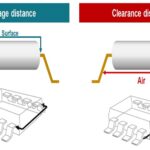In general, digital isolation can be implemented using capacitive, giant magneto restrictive (GMR), and magnetic technologies. The digitally isolated gate drivers used to drive silicon carbide (SiC) and gallium nitride (GaN) devices plus silicon power MOSFETs and IGBTs in green energy systems like electric vehicles (EVs) and solar inverters mostly rely on magnetic isolation techniques, including coreless transformers or coupled inductors with silicon dioxide (SiO2) insulation systems.
Industrial operations benefit from using high-efficiency motor drives. Galvanically isolated coreless transformers (CT), also called coupled inductor-based gate drivers, are key components enabling high reliability and high-efficiency motor drives. The CT isolation is fabricated on-chip and consists of metal spirals with SiO2 insulation (Figure 1). The resulting driver supports an input-to-output offset voltage of 2.3 kV, input-to-output propagation delay of 100 ns with a part-to-part variation of ±7 ns, and features a CMTI of 200 kV/µs. This device is also suited for use in solar inverters.

Solar energy harvesting installations use 1.5 kV power buses to reduce cable cross-section, weight, and cost while delivering high power. That requires that the power switches in the inverter are rated for at least 1.7 kV, with many designs using 2 kV switches for additional reliability. Solar inverters employ a closed-loop architecture where a digital controller modulates the power switch duty cycles to force the inverter output voltage amplitude and phase to match the grid. The use of integrated galvanically isolated drivers eliminates the need for external isolation components and simplifies system design. Each driver output is isolated, enabling a mix of positive and negative voltage rails to be used without latch-up concerns.
In these designs, feedback to the inverter controller is provided by CMOS-isolated AC current sensors. Depending on the package, these sensors can have up to 5 kVrms isolation. As a result of their monolithic CMOS construction, these current sensors deliver higher accuracy and reliability over a wider temperature range compared to discrete current sense transformers. In addition, the sensor is reset on a cycle-by-cycle basis using the inverter gate control signals eliminating the need for a separate reset circuit.
Digital interfaces & ΣΔ
In motor control applications, optical encoder feedback and resolve-to-digital conversion are often used in the feedback control system. More recently, digital isolators and galvanically isolated analog-to-digital sigma-delta (ΣΔ) modulators have appeared. These devices feature a 3.75 kV standoff voltage and high pulse precision. That enables high-performance motor systems that meet the latest efficiency standards and provide the control needed to minimize the harmonic content on the output of solar inverters.
In EV DC charging stations, ΣΔ modulators are used to sense the input and output currents and voltages of the power factor controller (PFC) in the AC input stage and the DC/DC output stage connected to the battery pack. That requires a high accuracy ΣΔ modulator. Galvanic isolation can be used to eliminate stray currents that can cause data errors across the barrier. It also provides high levels of CMTI. The integrated solution has 6 kV SiO2 isolation technology and dual channels that can transfer data between an HV and LV domain at up to 100 Mbps with a pulse distortion below 3 ns (Figure 2).

Summary
Digitally isolated gate drivers are increasingly important in a range of green energy applications, from industrial motor drives to solar inverters and EV chargers. In addition, isolated AC current sensors and isolated ΣΔ modulators can contribute to improved performance and higher reliability.
References
Advanced Digital Isolation Technologies Boost Solar Power Inverter Reliability, Skyworks
Advantages of coreless-transformer gate drivers over gate drive optocouplers, Infineon
Galvanically isolated products for DC EV charging stations, STMicroelectronics
Isolated Gate Drivers, Analog Devices







Leave a Reply